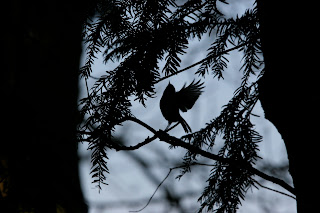It is good to see the House Sparrows return to the garden in force. Each
morning they arrive from further down the street, a boisterous posse of
grey-capped males and chattering females. This chattering becomes all the more
evident once the birds have fed, the flock retiring to the thick of next door’s
jasmine to indulge in communal banter. ‘Social singing’, as it is known,
appears to be an important component of House Sparrow behaviour, its role tied
in with social status and flock cohesion.
These are sociable birds and the winter flocks bring together
individuals from several local colonies. Many of the youngsters present within
these flocks will roost together in thick vegetation, while established pairs
often retire to their nest site. Winter flocks of this kind not only provide
benefits in the form of greater knowledge of food availability and lower
individual risk of predation, but they also serve as the opportunity through
which young birds can disperse away from the colony in which they were born.
Cohesion of sparrow society comes from the social hierarchy that is
established through plumage and display, and ultimately backed up by force if
necessary. In the eyes of a female, the badge which illustrates the suitability
(and hence status) of a male is the size of his black bib. The most successful
males are those with the biggest bibs and you will see subordinate birds
quickly defer to these high-ranking males in many social situations (most
notably in access to food, dust bathing opportunities and females).
Our House Sparrows were visitors when we first moved into this house but
we lost them soon after, the landscaping of a neighbouring garden removing the
cover they favoured and they ceased to venture this far up the street. Now that
the vegetation next door has matured, we have seen their return. House Sparrows
rarely venture far and for several years it has been frustrating to hear the
colony further down the street, knowing they would only rarely reach our garden.
Cover is important for House Sparrows, providing feeding opportunities,
protection from predators and a platform for the social singing. Other factors
also play a major role in determining House Sparrow numbers, and key changes in
the nature of urban landscapes have seen the House Sparrow population
effectively halve since the early 1980s. The loss of nest sites, following the
introduction of new designs of roofing tile and barge board, coupled with the
clearance of scrubby habitats, increased use of pesticides within our gardens
and increasing numbers of competitors and predators have all been linked to
sparrow decline, even though we have yet to determine which of these is the
most important.

